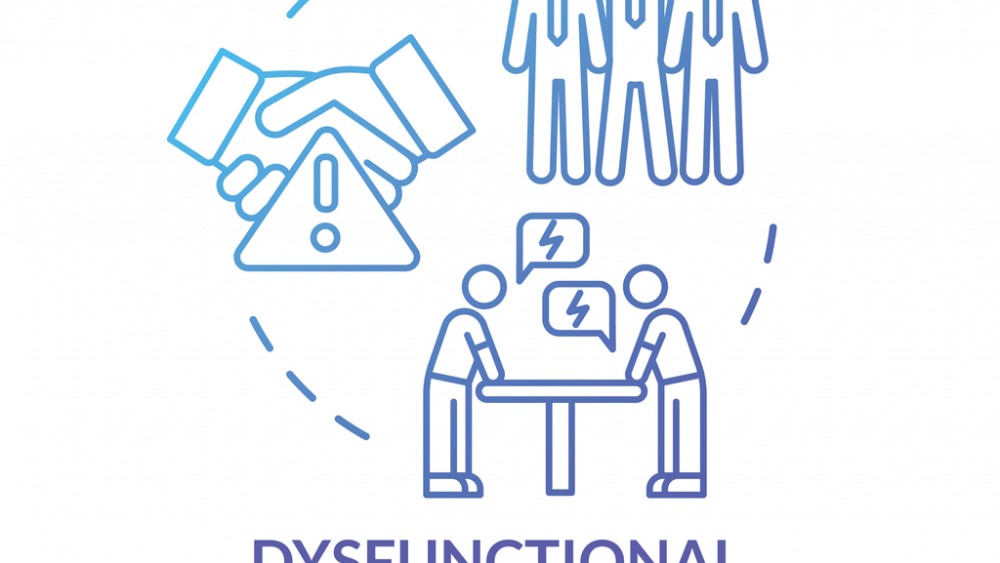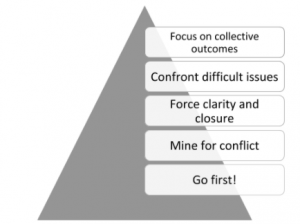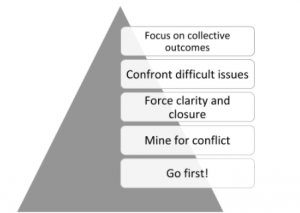
The 5 Dysfunctions of a Team: How leaders can prevent and resolve them
It’s Monday morning and you’ve just started the workday. You go to your desk, turn on your computer, and open up your email. You turn around to take something out of your briefcase when you notice a notification sound on your computer.
It is an email from your boss notifying you of a team meeting you have in 30 minutes. When you get to the team meeting, your boss asks around the room about why the team is not reaching the goals set for them. Silence occupies the room, while you and possibly the rest of the team sit there thinking, “If you would just admit that you set un-accomplishable goals to complete in an unreasonable amount of time, then you would have your answer.” Your boss then looks at you and the rest of the team and says, “I’m willing to take any feedback about how I can help the rest of the team.”
Silence again.
What is the problem here? Is the boss being unfair on purpose? Are the team members responsible for not accomplishing the goals set? What is dismembering this team and leading them towards poor team dynamics? Many people face similar situations in the workplace and especially in team meetings. In fact, most employees admit that they hate attending meetings due to the consequences of the meeting itself.
But team meetings do not have to be something that team members loathe. In fact, team meetings should be quite the opposite; they should provide employees a chance to interact with their coworkers, to gain insight and knowledge about what they should be doing, to learn effective ways to perform to achieve their goals, and motivation from the rest of the team to perform well. In order to create this fantasized, but simply achievable version of a team, then one thing must be done. The team must face and overcome five common dysfunctions of a team.
A team meeting, and team in fact, usually consists of a team leader and team members (this will become relevant when bringing up the five dysfunctions). Teams often lack in two areas: team dynamics and team structure. The five dysfunctions of a team deals with both areas with an emphasis on team dynamics and looks something like this:
The Five Dysfunctions of a Team, seen above, is a concept and popular book by Patrick Lencioni. In his book, Lencioni talks about why team meetings and teams in general fail to build effective team dynamics while introducing the five dysfunctions – absence of trust, fear of conflict, lack of commitment, avoidance of accountability, and inattention to results. The order of these dysfunctions is also no mistake because as Lencioni explains, you cannot have effective conflict without having trust and so on.
Now imagine that same meeting you’re attending, and think about the level of trust each team member has with each other/with their team leader. Do you think that the team members trust the team leader/each other? I’ll simply answer this questions with a ‘no’. In order to have trust you must first be able to demonstrate vulnerability. Now this sounds kind of weird, but vulnerability based trust means being able to genuinely admit to your other coworkers when you need help, when you really messed something up, when you are sorry for something, etc…. This approach, although it may be surprising, is actually the best way to form an open team environment. At the same time, when just one team member lacks vulnerability based trust, then their defensiveness and lack of trust can and usually spreads to the rest of the team, which creates team resistance. Now why did so much silence occur in the meeting in the above example? Well a part of it is an absence of trust among the team, and another part is due to a fear of conflict.
Almost everyone is afraid of and dislikes conflict for numerous reasons such as: conflict is awkward and demeaning for people which results in everyone being angry in the end. But what if I told you that conflict is actually good for the workplace? Let me tell you a little story. In 2003 NASA was planning on sending seven people to space on an exciting mission. Years of planning was invested until everything was just right for these astronauts to depart. When the space shuttle took off, everything seemed fine except a small foam block fell from the shuttle and damaged the shuttles wing. Several team meetings were held and there was consensus from almost all team members that the damage was minor and that the crew could re-enter Earth’s atmosphere to come back home. Only the Space Shuttle Columbia crew never did make it back home. Once the space shuttle re-entered the Earth’s atmosphere, the damage to the wing allowed hot gases to break apart the structure. It was later noted that many engineers did not feel that it was safe for the crew to come back to Earth until damage was repaired, but lack of conflict due to impulsivity urged a hasty and deadly decision by NASA’s management who ignored the engineers’ opinions omitting any chance of effective conflict. While many team meetings do not associate with such deadly implications, it is important that teams use conflict to make sure that consequences like these do not occur. In addition, if a team can learn to manage conflict, then great relationships will form and team members will be able to commit to more decisions.
This brings up the next dysfunction of a team: lack of commitment. How many times have you thought an idea from a team meeting was not good, voiced your opinion, and when the idea was carried out it eventually failed? You knew the idea was bad all along; why did the rest of the team decide to carry it out in the first place and not listen to you? Of course that had to be the reason the idea failed right? Wrong (in most cases). In most cases the failure associated with these ideas that we didn’t think should be implemented in the first place is due to our lack of commitment to the idea. That is why although there is disagreement with an idea, it is important to still commit. A lot of the time people would rather be right than help their organization succeed with an idea they did not agree with, which is why they passively commit. They stand on the side line and watch the idea crumble just like they said it would until it fails instead of helping the rest of the team try to achieve the team-decided goal along the way. Instead, team members who disagree and don’t get their way must commit and try to help their team achieve these goals anyway. Honestly, this is a better option for them anyway because team members often view others who disagree but commit to an idea as more authentic than those who disagree and sit back judging the idea along the way.
Once commitment is reached among team members, then they are able to hold each other accountable. Now you may be saying, ‘hold each other accountable? That sounds like a bad thing!’. Quite the contrary. In fact, without accountability, a team will not be able to adjust to maintain and optimize their team performance. Secondly, demonstrating accountability does not have to be a bad thing at all! In the event that trust occurs, conflict is good, and team members are comfortable with each other, accountability can serve as a way for members to benchmark other’s performance and help them out along the way. It is also an opportunity for team members to display trust by asking for help or admitting that they have been struggling with a piece of the work to the point where the rest of the team can help that team member out. While many think that holding accountability has to do with blame and singling out a team member to diminish team member relationships, it should actually do the opposite! If a team environment maintains trust and great team dynamics, then questioning someone as to why they have had low performance while offering assistance should lead to the rest of the team helping that team member out while strengthening team member relationships.
Finally, without accountability, a team will have inattention to results. Results can be viewed in business as the biggest driver of motivation. Simply, organizations focus on results above anything else because without delivering results, they would not exist as an organization. Results are the bottom line most time, but what many people don’t realize is that regardless of accomplishing a team goal to deliver results, team members do not always focus on the team’s outcomes. In fact, on many occasions, team members will focus more on their personal needs like ego, career development, or recognition above the collective outcome desired for the team. While it is great for individuals to set personal goals, it is important that team members are focused on the latter: the collective team’s goals to deliver team results. While it is great that individuals are achieving and bringing great results to the organization, if they are not focused on or working towards the team’s goals, then this is dysfunctional for a team.
Now that I have explained the five dysfunctions of a team hierarchy, you probably want to know, “how do I prevent/repair these dysfunctions?” It is not surprising that the team leader plays a huge role in the solution portion for the five dysfunctions of a team. It is also important to note that while solutions are geared toward leaders’ influence, styles, and behavior, team members should bring a level of self-awareness to the team and recognize when the team or themselves are succumbing to the five dysfunctions as much as they can. The leader’s roles can be seen below:
Let’s start with the first level and work our way up. Absence of trust: When a leader finds that there is an absence of trust among the team, this can simply be negated by going first by showing vulnerability first. If the team does not trust each other and team members put their shields up, then it is up to leaders to lead by example and display their vulnerability by admitting their faults and showing candidness if they expect the rest of the team to do so. The next level: fear of conflict, can simply be mended by leaders searching out, bringing up, and encouraging respectful and healthy conflict from team members. This demonstrates to the rest of the team that conflict is okay and even encouraged as long as it truly is brought up to objectify team ideas in order to optimize them. Third: lack of commitment should fall upon the leader to force clarity and closure by breaking the tie. Often when teams argue enough, they cannot make decisions to commit towards because everyone has their own equal opinion. It is up to the leader to show that they have heard everyone’s opinions and clearly state the decision that they have decided upon. Once the rest of the team sees that their opinion has been heard and a decision has been made, regardless of whether it is against their opinion or not, they are still willing to commit. Fourth: avoidance of accountability; it is up to the team leader to try to build peer-to-peer accountability, the best type of accountability, by actually confronting difficult issues. Instead of avoiding ‘having the talk’ and not holding team members accountable, leaders must demonstrate that they value and will hold accountability. Once this occurs, team members will hold each other accountable because they know if they do not, then the team leader will anyway. The last dysfunction: inattention to results can be abated by setting the tone for a focus on results and tying rewards and recognition only to those who perform towards and accomplish team goals. If team members feel that the leader values or rewards anything other than team goals, then they are going to start working on their personal agendas while shifting their focus away from collective team goals. It is up to team leaders to incorporate these behaviors into their leadership styles to avoid and overcome the five dysfunctions of a team. With these tools, teams will be better equipped to perform well with the opportunity for great team dynamics.
Now that I have explained the five dysfunctions of a team, you are probably adding Patrick Lencioni’s book to your cart so you can read it too!
To finish up I will conclude in a similar way that Patrick Lencioni would conclude. There are many leadership tools that allow teams to overcome and prevent these five dysfunctions. Without them and without teams trusting each other, they cannot demonstrate effective conflict that will help them commit to decisions even though they don’t agree which will not allow them to hold each other accountable for lack of performance and finally will not let them focus on collective team results. And that is the five dysfunctions of a team ladies and gentlemen. Please use this in your workplace and in life when collaborating with others as it is a great resource to help teams.
Lencioni, P. (2002). The five dysfunctions of a team: a leadership fable. San Francisco : Jossey-Bass, c2002.



